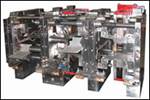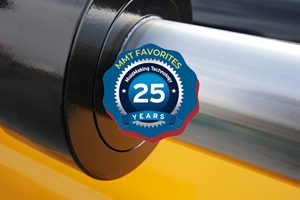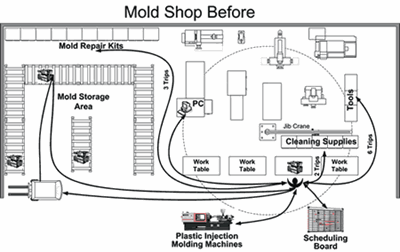Lean Manufacturing: Moldmaking through the Lean Lens
In order for mold manufacturers to accept lean, we must first dispel the myths.
Lean manufacturing has cemented its position as a powerful method of transforming operations of all types. It has been credited for the success of companies from automotive to healthcare to hotels. However, success with lean in moldmaking has not come easily. Lean in the moldmaking industry can be described as immature with only pockets of success. Many companies have applied “surface” lean with tools such as five S. But, surface lean just changes the look of things; the processes below the surface are where the real opportunity can be found.
The business of moldmaking is different from many of their customers, such as aerospace or automotive. Being different, however, is not a reason for lean failure, as is the opinion of many moldmakers. Being different means that you cannot copy lean from a high-volume repetitive manufacturing environment. Lean can be applied, but just as a hotel or hospital or laboratory must do, it must be adapted to your needs and environment.
Lean Myths
To start, three myths of lean must be dispelled. Each one is important to the acceptance of lean in the moldmaking industry.
Myth 1: Lean was made for high-volume repetitive manufacturing environments.
I once received a call asking “Does lean work in a machining environment?” I almost laughed, because lean had made the most advances in the machine shops of Toyota under Taiichi Ohno. And, these were not high-volume shops-low runs, lots of setups and very little automation was the norm.
If you believe lean is about U-shaped work cells and kitted pull-based production with kanban cards, then I can see how you would say that lean is not effective in the moldmaking environment. However, this is not lean. This description is lean in a flow environment. Let’s visit an altogether different environment to make this point.
Ever visit a hospital? Clearly, lean is not going to be about U-shaped cells. You are not going to design a surgical room or an emergency center in a U-shape, moving the patient around from step to step. Nor will an emergency room adapt to takt time, the lean concept of producing to the average customer demand rate over a period of time. Surgeons don’t know on any given night how many patients they will get or what their conditions will be.
So what does lean mean here? Lean in healthcare, as it should be in moldmaking, deals with using the lean lens of effective process design to solve the relevant prob-lems. For example, consider the problem that nurses spend two-thirds of their time searching for material, information or help. Apply the lean lens to the problem and then design the appropriate solution.
Myth 2: Five S and Kaizen will make you lean.
Five S and Kaizen are such popular lean tools that some people don’t even realize they are connected to lean—they have become programs unto themselves. They are generally effective tools, often producing powerful and compelling results. But, lean is not about tools. Lean is about how an organization thinks, makes decisions, processes information and behaves.
Consider the simple example of five S. What is its purpose? When I ask this question of companies applying the tool, they will rattle off a list: cleanliness, discipline, waste elimination, tour-readiness and employee morale. But, if I have to choose whether to spend time shipping product or being tour-ready, the success of five S will quickly deteriorate. This is not the purpose of five S. Its real purpose is to surface problems quickly. If my tools are labeled and outlined, when a tool is missing, I will notice it right away. Otherwise, I might not find out it is missing until I am in the middle of a job. Knowing ahead of time will allow a more effective solution.
The point is, if lean is not based on the principles an organization uses, tools will not be effective. The principles and beliefs of an organization will determine how effectively they use the tools of lean and how it creates new solutions as responses to new problems.
Myth 3: Lean is all about front-line employees.
Before you jump down my throat on this point, lean is about greater engagement, empowerment and enrichment of all employees from the front-line to the board room. However, many companies believe that lean begins and ends with the shop floor and the front-line employee. Typically, employees are trained in lean basics, given a suggestion box and a team meeting board and then told to make the company better. They then come up with the “wrong” ideas or the organization can’t support all of the ideas. Both the employees and management get frustrated, which leads to the eventual demise of the lean “program.” This is only a slight exaggeration of what I have seen in dozens of companies.
There are several problems with this approach to lean. First, front-line employees have exposure to only some of the problems, certainly not all of them. There is tremendous value in identifying all of the opportunities that save 10 minutes or $100 or 1 pound of material. However, we also need people working on the handful of 1,000-hour and $1M problems.
Second, an organization that empowers its front-line employees, but does not build an organization that supports that empowerment—from the supervisor to the CEO—will fail. The fact is, lean requires more change in management than it requires in front-line employees. If management doesn’t understand lean at a deeper level than their employees, the employee frustration will only grow. If management does not act on the ideas that the employees offer, the employee frustration will grow some more. If management cannot live the lean principles that they are asking of their employees, the employee frustration will grow and grow and grow. Lean does not have to begin with the CEO making a deep-dive commitment to a personal and dramatic lean transformation, but it cannot be delegated to the front lines without changing management.
Making Progress
Understanding these myths of lean will help you avoid the common mistakes that have resulted in another lean myth—that lean does not apply to the moldmaking industry. The following guideposts will help you make progress once you denounce these lean myths.
Guidepost 1: Value is solving the customer’s problem.
In industries such as moldmaking, we often get overly focused on fulfilling the order or responding to the request for quote, losing sight of something more important—the customer is paying us to help them solve a problem. Those companies that better understand their customers’ problems are more likely to deliver more value for fewer dollars to those customers. Those companies are the ones that gain in market share, which is particularly important if the market is shrinking.
How do you do this? Put yourself in the customers’ shoes. See how they use what you are giving them and find out what is most important to them. Still struggling? Ask your customer! Of course, the customer is NOT always right, but they will tell you if you are not providing value.
What if the customer gets in your way of providing them value? They wouldn’t be the customer. Show them how they can help you to help them. Your customer won’t accept that it is their fault you didn’t provide value when they find another supplier.
Guidepost 2: Lean is born from how you think.
Learn lean principles. Then, live them. Our principles drive our behaviors. Our behaviors determine our actions. Our actions produce our results. We may say we believe something, but the real test of what we believe is when we are pressured. How we act when our backs are against the wall is a demonstration of our true principles.
Lean is not common sense. Otherwise, it would be more common. Adopting lean principles means having people make different decisions than they might otherwise. For example, if you believe in eliminating the waste of overproduction, you would not run a machine ahead of when the next step needs it. Try it—it’s harder than it sounds. True lean begins with true lean thinking.
Guidepost 3: Lean is a journey, not a checklist.
Too many companies look at lean as a destination. Like packing for a trip to that destination, they look at implementation as a checklist. Toothbrush? Socks? Check!
Five S? Work cell? Check! Lean is a journey. That journey is driven by True North—a description of the ideal state of your process and of your organization. That ideal state will sound impossible, impractical and even silly. But it is not your destination. It is your compass. You strive to get one inch closer to it each and every day. Deliver your product within one shift? Ridiculous! But what action can you take that gets you one inch closer to that ideal state?
This sounds like hard work. It is. That is what makes it great. Those who pursue lean with vigor and commitment are pursuing greatness. As Vince Lombardi once said, “Perfection is not attainable. But if we chase perfection, we can catch excellence.”
Related Content
The Benefits of Hand Scraping
Accuracy and flatness are two benefits of hand scraping that help improve machine loop stiffness, workpiece surface finish and component geometry.
Read MoreThe Ins and Outs of Hot Runner Temperature Control
A training checklist that explains the why and how of proper hot runner temperature control and system management.
Read MoreRevisiting Some Hot Runner Fundamentals
What exactly does a hot runner do? If you’ve been in the injection molding industry for any length of time, you might think the answer is obvious, but it is not.
Read MoreHow to Correctly Size a Hydraulic Cylinder
This week Randy shares steps for correctly sizing a hydraulic cylinder on a mold.
Read MoreRead Next
StackTeck: Lean Strategies Combine for Niche Molds in Record Time
This one-stop shop powerhouse goes lean—cutting leadtimes nearly in half and earning MoldMaking Technology's 2005 Leadtime Leader: Large Shop Honorable Mention.
Read MoreFocus on Tooling Access to Improve Productivity
How to apply lean tools at leverage points in a mold shop to achieve a focused business objective.
Read More














